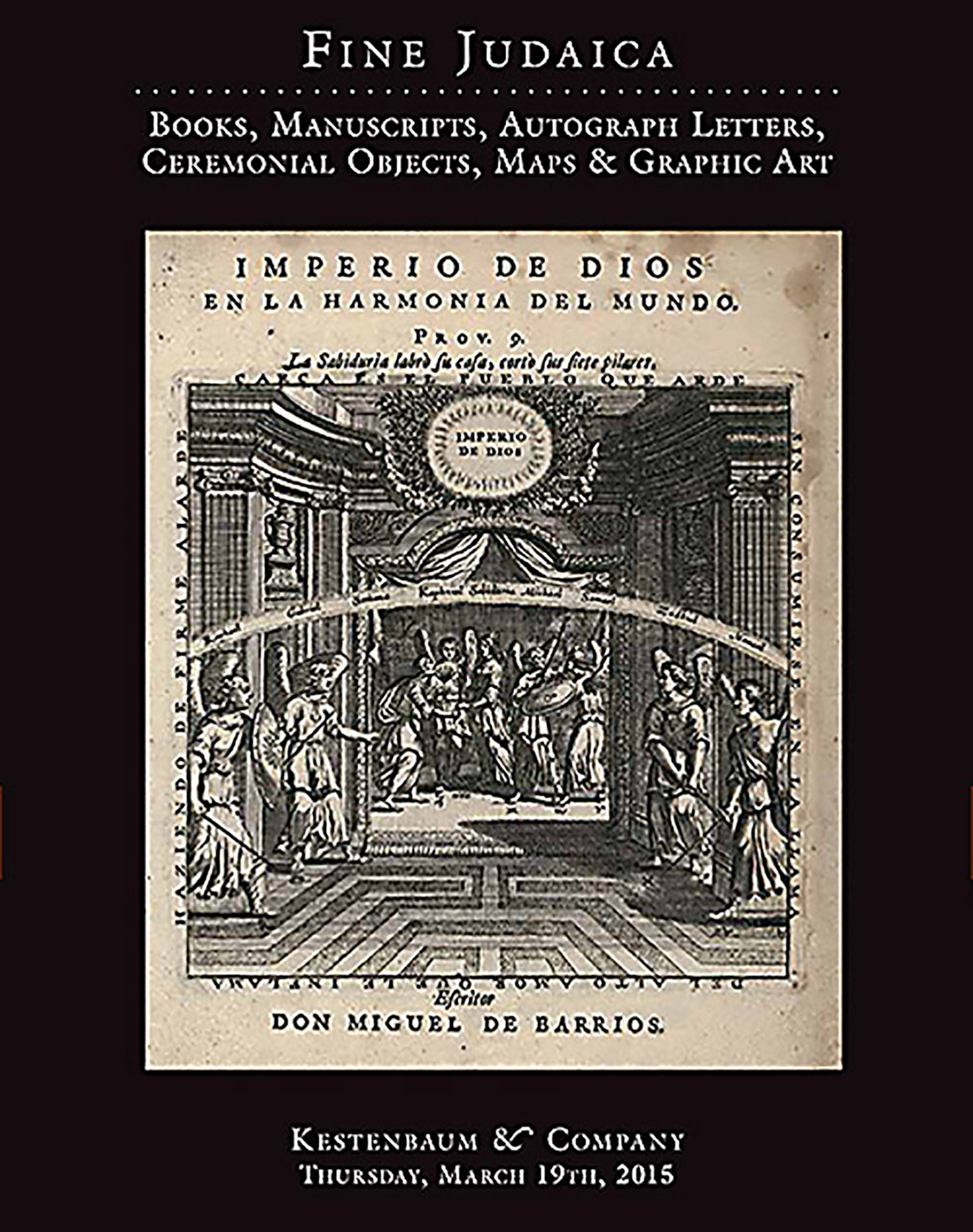Masechta Kidushin. With commentary of Rashi.

AUCTION 64 |
Thursday, March 19th,
2015 at 1:00
Fine Judaica: Books, Manuscripts, Autograph Letters, Ceremonial Objects, Maps and Graphic Art
Lot 181
(TALMUD, BABYLONIAN).
Masechta Kidushin. With commentary of Rashi.
(Guadalajara: Solomon ben Moses Alkabetz HaLevi, circa 1480-82)
Est: $20,000 - $30,000
PRICE REALIZED $37,500
<<THE VERY FIRST EDITION OF TRACTATE KIDDUSHIN. FOUR HEBREW LEAVES FROM SPAIN OF THE VERY UTMOST RARITY.>>
The very first publication of Talmudic Tractates was in Spain, however due to the mass destruction of Hebrew books during the Spanish Inquisition, Hebrew incunabula printed there are notoriously rare - indeed according to Offenberg they have almost entirely disappeared. Consequently, Offenberg considered the British Library’s Spanish Tractate “a unique copy…(although it is) incomplete at the beginning, middle and end (and) the signature collation uncertain” (BL p. 84). According to Offenberg, aside from the British Library copy, only four fragments exist of this Guadalajara incunable, all of which were accidentally discovered within the bindings of other books.
<<DATE:>> Although Van Strallen estimates the date of publication to be 1485(?), E. N. Adler establishes the date of the Guadalajara Tractate Kidushin as 1482. Joshua Bloch notes that the last publication issued by the Alkabetz press to have been 1482.
<<ACCURACY OF THE TEXT OF TALMUD AND RASHI:>> Both Joshua Bloch and Alexander Marx conjectured that the significant variants found in both the text of the Talmud and Rashi in the Spanish Tractates likely derive from early, accurate manuscripts which came to Spain from the Geonic Academies in Babylonia. Indeed after a careful comparison of the present leaves, one notes a different order of the text, as well as extra lines, words and letters, even elimination of text in certain cases and other variants (including orthography) - amounting to a text significantly unlike that of the Bomberg edition and the much vaunted “Vilna Shas.” Some of these variants are significant enough to change the meaning of the Gemara. For example, the standard text on f. 67b “eved sheba al Shifcha” has been corrected by the Maharsh”a to read differently. The Maharsha’s correction is exactly as appears in this edition. This indicates the superior textual accuracy of this Spanish edition. In addition, the final three lines of this folio are not published at all in the standard Vilna edition. This edition also has smaller phrases or short sentences missing from the standard edition. For example at the end of the second leaf “B” in the paragraph starting “Hanicha L”R Yeshavav” our edition has the following phrase not in the standard edition: “Ika Leukma bechayavei aseh Mitzri ve’edomi.” This adds a different twist to the reasoning in the text.
Our text of Rashi here also contains many variants and more accurate readings. For example, Rashi in the standard edition (67b passage starting with the word “minayin”) refers to ‘nations’ which are not from the land of Israel, in this Spanish edition, we have the more accurate reading “Meshiva Umoth she’be’Eretz Yisrael” [”from the ‘seven nations’ of the land of Israel.”] None of these meaningful variant readings are found in the recently published “Oz VeHadar” edition of the Talmud which went to great lengths to examine earlier texts. Clearly, these Spanish fragments are a new revelation, for even the minor variants assist in obtaining a smoother reading of the text.
A final note of interest, since this Guadalajara edition was printed prior to the Inquisition, it is free from censorship. Thus, whereas the standard Talmud editions employ the circumlocution “aku”m” for Gentile, here the original reading “goy” is retained (see the final lines of the verso of leaf “D”.
<<PLACE OF PUBLICATION AND PRINTER:>> Guadalajara was an important Jewish center North East of Madrid. The grandson and namesake of the printer was Solomon Alkabetz (c.1505-1584), the famous liturgical poet, author and Kabbalist, venerated today as the composer of “Lechah Dodi,” the mystical love-song to the Sabbath.
As a final point of reference: Discovering an altogether different Spanish incunable fragment elicited the following frisson of excitement from the esteemed Librarian of Hebrew Union College: “The rarest books, understandably, (are) those from Spain and Portugal. The acquisition of any Hebrew incunabulum is…noteworthy, and the library is proud to report the acquisition of… albeit it only a fragment.” (H.C. Zafren, Studies in Bibliography and Booklore, Vol. XII, p. 45).
<<REFERENCES:>>
Adler, Talmud Printing Before Bomberg in: Simonsen Festskrift (1923) pp. 81-4;
Adler, Talmud Incunables of Spain and Portugal in: Kohut Festschrift (1935) pp. 1-4;
Bloch, Early Hebrew Printing in Spain and Portugal, p. 18.
Dimitrovsky, Sridei Bavli (1979) Vol. I: Introduction;
Goff-Heb 113 ;
Heller, Printing the Talmud (1992) pp. 20-9;
Iakerson, JTS Cat. (2005) Vol. II, no. 90;
Offenberg, British Library Cat. (2004) p. 84;
Offenberg, Census 132;
Rabinowitz, Ma’amar al Hadpasath HaTalmud, p.31;
Tishby, Incunabula in Israel, KS, Vol. 59, pp. 946-58, no. 66;
Vinograd, Guadalajara 23;
YU Museum Catalogue, Printing the Talmud, no. 12.
